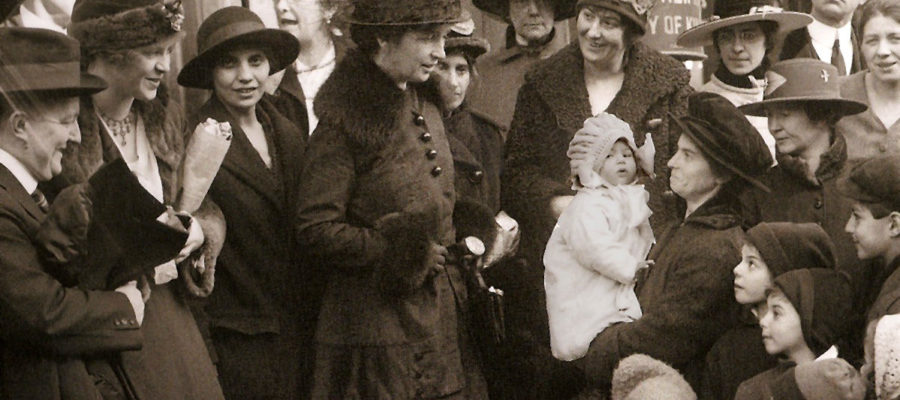Margaret Sanger was a eugenicist. Why are we still celebrating her?
December 5, 2017 | Published first in America Magazine
The French have a word for it: débaptiser.
A prominent French scientist, Alexis Carrel (1878-1944) won the Nobel Prize for his inventions. His work saved military and civilian lives during both world wars. After his death, a grateful nation baptized the medical school of Lyons as Alexis-Carrel University. In the 1990s, however, critics recalled that Carrel had been an ardent eugenicist. In his book Man the Unknown (1935), Carrel recommended the use of gas chambers to deal with criminals and the insane. In the 1936 preface to the German edition, he praised the new National Socialist government’s eugenic policy of forced sterilization. The French government quickly debaptized Alexis-Carrel University and rebaptized it in the name of T. H. Laënnec, the uncontroversial inventor of the stethoscope.
In our own nation the work of debaptism continues apace as we confront our racist history. Calhoun Hall at Yale has been renamed. A senator and vice president, John Calhoun was an ardent defender of slavery and white supremacy. Georgetown recently removed the names of Thomas Mullady and William McSherry from campus buildings since both Jesuits had been prominent in the sale of slaves to distant Southern plantations in 1838.
Sanger argued for compulsory sterilization and segregation for people with disabilities.
As we purify our national memory, I would like to nominate my own candidate for debaptism: Sanger Square in Manhattan. Named after Margaret Sanger (1879-1966), the founder of the Birth Control League (the future Planned Parenthood), the square honors an improbable feminist icon who championed a coercive brand of eugenics.
Sanger’s eugenics creed is clearly stated in her speech “My Way to Peace” (1932). The centerpiece of the program is vigorous state use of compulsory sterilization and segregation. The first class of persons targeted for sterilization is made up of people with mental or physical disability. “The first step would be to control the intake and output on morons, mental defectives, epileptics.” A much larger class of undesirables would be forced to choose either sterilization or placement in state work camps. “The second step would be to take an inventory of the second group, such as illiterates, paupers, unemployables, criminals, prostitutes, dope-fiends; classify them in special departments under government medical protection and segregate them on farms and open spaces.” Those segregated in these camps could return to mainstream society if they underwent sterilization and demonstrated good behavior. Sanger estimates that 15 million to 20 million Americans would be targeted in this regime of forced sterilization and concentration camps. In Sanger, the humanitarian dream of a world without poverty and illness has deteriorated into a coercive world where the poor, the disabled and the addicted simply disappear.
Sanger represents a genteel prejudice shared by many members of America’s ruling class in the early 20th century.
Sanger’s eugenics project carried its own racial preoccupation. In a letter of Dec. 10, 1939, to Clarence Gamble (cited here), she explains the nature of her organization’s outreach to the African-American community: “The most successful educational approach to the Negro is through a religious appeal. We don’t want the word to get out that we want to exterminate the Negro population, and the minister is the man who can straighten out that idea if it ever occurs to any of their more rebellious members.” In her autobiography she proudly recounts her address to the women of the Ku Klux Klan in Silver Lake, N.J., in 1926.
Dethroning a cultural idol like Sanger is not easy. The problem goes deeper than the link between her birth control movement and the sexual revolution. Sanger represents a genteel prejudice shared by many members of America’s ruling class in the early 20th century. To face squarely the glacial eugenics of Sanger one must demythologize the Progressive movement’s pantheon: Theodore Roosevelt (who staunchly supported the eugenic research of the Cold Spring Harbor laboratories), Woodrow Wilson (who as governor of New Jersey signed a law in 1911 mandating the forced sterilization of “the feeble-minded”), and Supreme Court Justice Oliver Wendell Holmes (who in the Buck v. Bell case in 1927 declared forced-sterilization statutes constitutional). Such biases have consequences. At least 60,000 American citizens were sterilized against their will under the weight of such mandates.
When we improbably debaptize Sanger Square, I propose a new baptismal name: that of Carrie Buck (1878-1966), the Virginia woman whose fate as a sterilization victim was sealed by the 1927 court decision. The state of Virginia had condemned Buck as feeble-minded, as incorrigible and as sexually promiscuous. She was in fact a C pupil, only mildly disruptive in class, and the child she bore out of wedlock was the result of being raped by the nephew of her foster parents.
For all our current efforts to face the destructive biases in our history, we find it difficult to admit, let alone condemn, our longstanding hostility toward people with disabilities and to confront those elites who have fostered that contempt. Our cult of Margaret Sanger is a sign of that enduring refusal.
Copyright 2017 America magazine. All rights reserved. Reprinted with permission.


